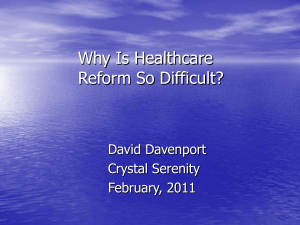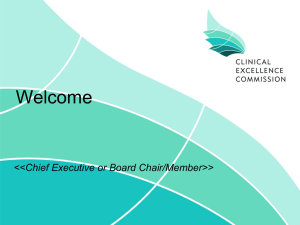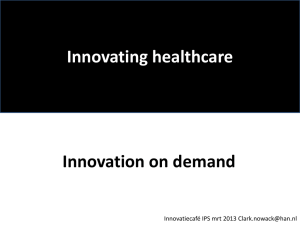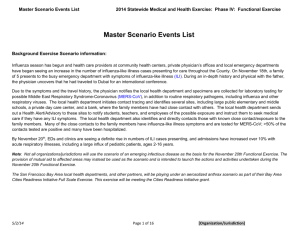Health care reform in China and its impact on
advertisement
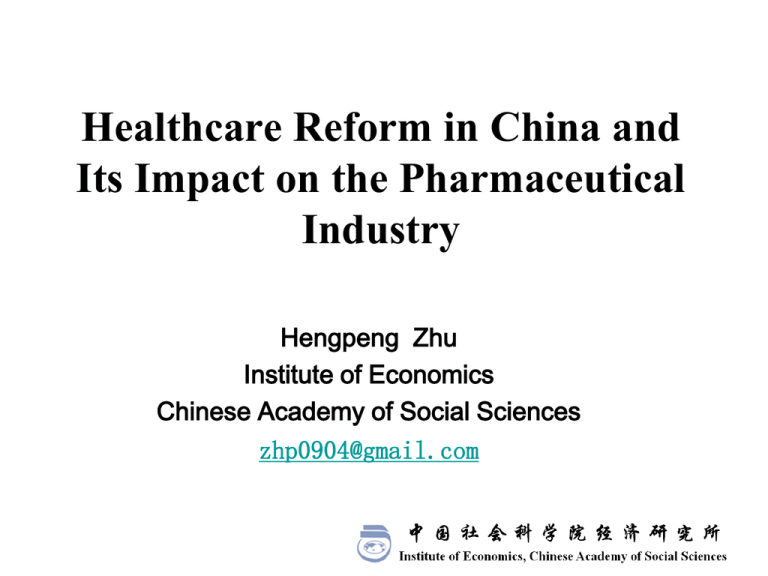
Healthcare Reform in China and Its Impact on the Pharmaceutical Industry Hengpeng Zhu Institute of Economics Chinese Academy of Social Sciences zhp0904@gmail.com The Size of Pharmaceutical Market in China • Pharmaceutical Expenditure in China will exceed $100 billion in 2010. Medicines sold through healthcare institutions account for 75% in domestic retail market. • In recent years, drug spending accounts for about 42% of the total health cost(1.9% of GDP). Characteristics of China’s Drug Market 1. Drug sales concentrates in the large and medium-sized cities . 2. Public healthcare institutions have been granted administrative monopoly power in drug dispensing. 3. Healthcare institutions prefer high-priced medicines to low-priced generic drugs. For most of health care institutions, drug sales revenue amounts to 60% of the total revenue, and in a few middle and small hospitals it is as high as 70-80%. Profit in drug dispensing becomes the major source of the hospitals’ financing. The Structure of Drug Dispensing in Hospital 1. The share of top 20 companies accounts for 32% of hospital’s drug retail sales. 1. The top 100 drugs sales accounts for 53% of hospital’s drugs retail sales. Top 200 drugs account for 73%. Why So ? 1. Financing for healthcare institution comes from drugdispensing profits 2. Public healthcare institutions have been granted administrative monopoly power in drug dispensing 3. The regulation on price markup rate from wholesale to retail 4. Administrative priority pricing for new drugs and lenient reviewing and approval of new medicine application 5. Fee-for-service system adopted by public medical insurance Main Objectives in China‘s Healthcare Reform 1. 2. 3. 4. 5. Universal coverage of social health insurance. National Essential Medicines System(EMs). Perfect primary health care system. Public hospital reform. Access to equal public health services Achievements • 94% of the population is covered through one of the four social health insurance. • Minimum per capita premium of social health insurance is 150 RMB (New Rural Cooperative Medical Scheme). • Doctor visits more than doubled from 3 to 7 • Hospital admission increased from 6% to 9% of every 100 persons. The EMs System in China 1. 2. 3. 4. 5. 6. Completed reviewing and revision of the essential medicine list. Annual open tender and centralized procurement at provincial level. Released the new guiding retail price ceiling of EMs (NDRC). Zero markup for EMs dispensing in public healthcare institutions 100% reimbursement of EMs by public health insurance. The financial loss of health care institutions caused by the sharp decline of drug sale will be made up in two ways: raising medical service price and increasing government subsidies. Challenges of the EMs System 1. Local governments are unable to offer adequate fiscal subsidy to compensate healthcare institutions. 2. Primary healthcare institutions are unable to raise price of medical services. 3. Therefore, primary medical institutions are incapable of implementing EMs system. Consequences of Forceful Enforcement of EMs 1. Enforcement of the EMs in primary medical institutions will exhaust the healthcare funding of local governments, leave them with no financial resources for public hospitals. 2. It will dis-incentivize doctors and medical service in primary medical institutions will deteriorate. 3. It will increase the volume of out-patient visits to and drug sales in the hospitals. Objectives of Public Hospital Reform 1. Separation of regulation from management & operation 2. Corporatization (making the public hospital corporate organizations) However, due to lack of motivation, local authorities and public hospitals have not initiated the above reform. Alternatives • Restructure the incentive mechanism of doctors and medical institutions through reforming provider payment of public medical insurance. E.g.,adopting capitation in outpatient reimbursement policy, DRGs and prospective payment system. This has become a general consensus between some central ministries and some local authorities. • Some local authorities have begun piloting. Result Early evidence indicated that it has changed the prescribing behavior of doctors and the drug dispensing pattern of medical institutions, together with universal coverage of social medical insurance, pharmaceutical companies with good cost-effective drugs are beneficiaries. Per Capita Medical Spending from 2007 to 2009 Average spending/visit : outpatient (RMB) Growth rate in 2009 2009 2008 2007 MOH-owned 305.2 281.5 281.5 8.4% Province-owned 238.4 219.8 200.0 City-owned 164.5 152.6 County-owned 1 126.8 County-owned 2 109.8 Growth rate in 2008 Average spending: inpatient (RMB) Growth rate in 2009 Growth rate in 2008 2009 2008 2007 0.0% 15197.3 13980.7 13117.4 8.7% 6.6% 8.5% 9.9% 12121.6 11084.1 10200.6 9.4% 8.7% 139.2 7.8% 9.6% 7216.2 6557.1 5892.5 10.1% 11.3% 117.8 112.5 7.6% 4.7% 4381.1 4115.3 3774.9 6.5% 9.0% 98.9 93.2 11.0% 6.1% 2978.6 2712 2491.9 9.8% 8.8% Opportunities • Growth rate of the total output of pharmaceutical industry in China has been 19.1% from 1993-2009. Its total output value will exceed 3,000 billion RMB($450 billion) by 2015 and 5,000 billion RMB($750billion) by 2020. • To achieve this goal,China must dramatically improve the innovation of its pharmaceutical industry, especially make great effort to support the development and growth of biomedical & pharmaceutical industry. Central government’s objective: total output value of biomedical industry should reach 40% of the entire pharma industry. • Local governments in economically developed regions all list the biomedical industry as their strategic priority in their 12th Five-YearPlan. Thank you!



